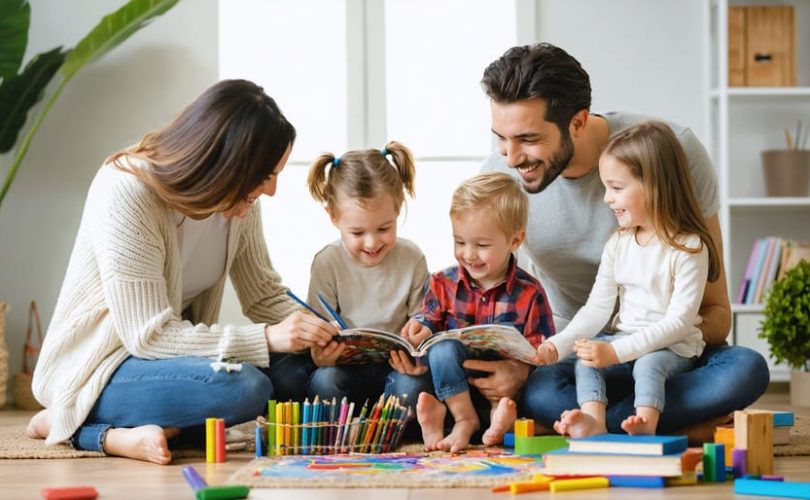Transform everyday moments into powerful connections by engaging in purposeful activities with your child – from morning routines to bedtime rituals. These deliberate interactions form the foundation of robust children’s mental health support and emotional development.
Create a dedicated “connection corner” in your home where you and your child can share daily highlights, worries, and celebrations without distractions. This sacred space becomes a trusted refuge for open dialogue and emotional expression.
Schedule weekly “emotion check-ins” through creative activities like art projects, storytelling, or simple board games. These structured yet relaxed interactions help children develop emotional vocabulary while strengthening parent-child bonds.
Studies show that consistent parental engagement reduces anxiety, improves self-esteem, and enhances academic performance. By incorporating these meaningful activities into your daily routine, you’re not just spending time together – you’re building resilience, emotional intelligence, and lasting mental wellness for your child.
These proven strategies create a supportive environment where children feel heard, valued, and emotionally secure. Start small, stay consistent, and watch as these intentional moments transform your relationship and your child’s emotional well-being.
Building Emotional Connections Through Daily Interactions
Quality Time During Routine Tasks
Daily routines offer wonderful opportunities to connect with your child while accomplishing necessary tasks. Turn mundane activities into meaningful moments by engaging your child in conversation and shared experiences. During meal preparation, invite your child to help measure ingredients or set the table, using this time to discuss their day or share family stories.
Morning and bedtime routines can become special bonding times. While helping younger children brush their teeth or get dressed, incorporate playful elements like singing songs or making up stories. For older children, use car rides to school as a chance for open-ended conversations about their thoughts, feelings, and expectations for the day.
Even household chores can become engaging activities. Folding laundry together creates a natural setting for casual chats, while gardening or cleaning can be transformed into games that make the work enjoyable. These shared tasks help children develop life skills while feeling valued and connected.
Shopping trips offer opportunities to teach decision-making and budgeting while spending time together. Let your child help create shopping lists, compare prices, or choose ingredients for family meals. These everyday moments might seem small, but they create lasting connections and provide children with a sense of capability and belonging.
Remember that quality time doesn’t require elaborate planning – it’s about being present and engaged in the moment, no matter how simple the task may be.

Active Listening and Emotional Validation
Active listening goes beyond simply hearing your child’s words – it’s about creating a safe space where they feel truly understood and validated. When your child shares their thoughts or concerns, maintain eye contact, put away distractions like phones, and give them your complete attention.
Try reflecting their feelings back to them with phrases like “It sounds like you’re feeling frustrated about what happened at school today” or “I can see why that situation would make you upset.” This shows you’re not just listening, but also understanding their emotional experience.
Remember to validate their emotions, even if you don’t agree with their perspective. Saying things like “That must have been really hard for you” or “It’s okay to feel that way” helps children feel accepted and supported. Avoid dismissive responses like “You’ll get over it” or “It’s not that big a deal.”
Create regular opportunities for meaningful conversations. This could be during daily activities like car rides, meal times, or bedtime routines. Ask open-ended questions that encourage sharing, such as “What was the best part of your day?” or “What’s been on your mind lately?”
When children feel heard and understood, they’re more likely to open up about their mental health challenges and seek support when needed. This foundation of emotional validation builds trust and strengthens your parent-child relationship.
Creative Activities That Foster Mental Well-being
Art and Expression Projects
Art provides children with a powerful outlet for expressing complex emotions they might struggle to verbalize. Through creative projects, parents can help their children develop emotional awareness while strengthening their bond. Consider setting up a dedicated art space where your child feels safe to explore their feelings through various mediums.
Start with simple activities like emotion-based coloring, where different colors represent different feelings. Encourage your child to create a “feelings rainbow” or draw their interpretation of various emotions. This activity helps them recognize and name their emotional experiences while providing valuable emotional development resources for future reference.
Clay or playdough modeling can be particularly effective for children who need to work through challenging emotions. The tactile experience of squeezing, molding, and reshaping materials can help release tension while creating something meaningful. Ask your child to sculpt what their worry looks like or shape their happiness into a physical form.
Create a family emotion journal using mixed media, incorporating drawings, magazine cutouts, and written words. This collaborative project helps normalize emotional expression within the family unit while creating lasting memories. Set aside weekly “art and feelings” time where everyone shares their creations and discusses the emotions behind them.
Remember to focus on the process rather than the result. The goal isn’t to create masterpieces but to provide a safe space for emotional expression. Validate your child’s artistic choices and ask open-ended questions about their work, fostering deeper conversations about their feelings and experiences.

Mindfulness and Relaxation Exercises
Practicing mindfulness together as a family can create powerful bonding moments while teaching children valuable emotional regulation skills. Let’s explore some gentle, family-friendly exercises that can help everyone feel more centered and connected.
Start with the “Rainbow Breath” exercise – have your child sit comfortably and imagine different colored breaths. Inhale red for strength, exhale orange for joy, and continue through the rainbow. This playful approach makes breathing exercises more engaging for young minds.
The “Body Scan Train” is another delightful activity where family members lie down in a line, like train cars. Take turns being the “conductor” who guides everyone through focusing attention on different body parts, from toes to head, helping children develop body awareness and relaxation skills.
Create a “Calm Down Corner” in your home with soft cushions, stress balls, and peaceful pictures. Teach children that this is a safe space to practice their mindfulness exercises when feeling overwhelmed. A parent shares, “Our calm corner has become our family’s favorite spot for emotional reset moments.”
For active children, try “Walking Like Animals” mindfulness. Move slowly like different creatures while focusing on each movement – stretch tall like a giraffe, stomp slowly like an elephant, or balance like a flamingo. This combines physical activity with mindful awareness.
End each day with the “Gratitude Garden” exercise. Have family members share one thing they’re thankful for, imagining each gratitude as a flower growing in a beautiful garden. This nurtures positive thinking and emotional expression while strengthening family bonds.
Remember to keep these exercises light and playful, never forcing participation. The goal is to create peaceful moments that children naturally want to join, making mindfulness a welcome part of your family routine.

Building Support Networks Together
Family and Community Involvement
Building strong family and community connections plays a vital role in supporting children’s mental health. Regular family meetings create a safe space for open dialogue, where children can express their feelings and concerns without judgment. Consider establishing a weekly “family council” where everyone gets equal time to share their thoughts and contribute to family decisions.
Community engagement can take many forms, from participating in local events to volunteering together. These activities help children develop empathy, social skills, and a sense of belonging. Many families find success in joining parent-child activity groups, sports teams, or cultural organizations that align with their interests.
Technology can also strengthen these connections, with digital mental health tools offering new ways for families to stay connected and support each other. Consider creating a family chat group or using apps that encourage positive interactions and emotional sharing.
Other meaningful activities include:
– Organizing neighborhood play dates or family game nights
– Participating in school parent committees
– Joining community service projects
– Attending cultural festivals and events
– Creating family traditions that celebrate achievements
Remember that quality time doesn’t always require elaborate planning. Simple activities like cooking together, taking evening walks, or sharing daily “highs and lows” can create lasting bonds and provide emotional support for children’s mental well-being.
Peer Support Development
Supporting your child in developing healthy friendships is crucial for their social-emotional wellbeing. As parents, we can play a vital role in helping our children navigate social relationships and build lasting connections with their peers.
Start by creating opportunities for social interaction through playdates, group activities, or joining local clubs. Observe how your child interacts with others and gently guide them when needed. For younger children, role-playing different social scenarios at home can help them practice friendship skills in a safe environment.
Teach your child essential social skills like sharing, taking turns, and showing empathy. Help them understand the importance of being a good listener and respecting others’ feelings. When conflicts arise, guide them in problem-solving rather than solving issues for them.
Encourage inclusive behavior by helping your child recognize and appreciate differences in others. Support them in reaching out to new classmates or peers who might feel left out. This not only helps your child develop compassion but also broadens their social circle.
Remember that every child develops social skills at their own pace. Some may be naturally outgoing, while others need more time to warm up to new friendships. Celebrate their progress and provide reassurance when they face social challenges. Creating a supportive home environment where they can discuss their friendship experiences openly helps build their confidence in social situations.
Creating Safe Spaces for Emotional Expression
Creating a safe emotional space for your child begins with establishing an atmosphere of trust and acceptance in your daily interactions. Start by designating specific areas in your home where your child feels comfortable expressing themselves – this could be a cozy corner with soft cushions, a special chair, or even their bedroom decorated with personal touches that make them feel secure.
Practice active listening by maintaining eye contact, nodding to show understanding, and avoiding interruptions when your child speaks. Remember that sometimes children need time to process their feelings before sharing them. A simple “I’m here when you’re ready to talk” can work wonders in building trust.
Consider implementing regular “feelings check-ins” during natural daily transitions, like after school or before bedtime. Use creative tools such as emotion cards, mood meters, or drawing exercises to help children who struggle with verbalizing their feelings. For younger children, puppet play can be an excellent way to act out scenarios and express emotions safely.
Dr. Sarah Chen, a child psychologist, suggests, “When children feel judged or criticized for their emotions, they learn to suppress them. Instead, validate their feelings by saying things like ‘It makes sense that you feel angry’ or ‘I understand why that made you sad.'”
Create family rituals that encourage emotional expression, such as sharing “peaks and valleys” of the day during dinner time or keeping a shared gratitude journal. These activities normalize talking about feelings and help children understand that all emotions are acceptable.
Remember to model emotional vulnerability yourself. Share appropriate examples of your own feelings and how you manage them. This shows children that expressing emotions is healthy and natural. When children see adults handling emotions thoughtfully, they learn to do the same.
Ensure that your safe space remains consistent by establishing clear boundaries around respect and confidentiality. Let your child know that while you might need to share certain information with other caregivers, their feelings will always be treated with care and understanding.
Engaging in activities with your children is more than just quality time – it’s an investment in their emotional well-being and mental health. Throughout this guide, we’ve explored various ways to connect, communicate, and grow together through meaningful interactions. These activities not only strengthen family bonds but also build resilience, self-confidence, and emotional intelligence in children.
Remember that consistency matters more than perfection. Even small, daily moments of connection can have a lasting impact on your child’s mental health. Whether it’s sharing meals, playing games, or participating in community events, each interaction contributes to your child’s sense of security and emotional development.
Don’t feel pressured to implement every activity at once. Start with what feels natural for your family and gradually incorporate new experiences. Stay connected with other parents, teachers, and mental health resources in your community to share experiences and learn from each other.
Most importantly, celebrate the journey of growing together. Your commitment to engaging with your child sets a powerful example of love, support, and emotional awareness that will benefit them throughout their lives. Keep showing up, staying present, and creating those precious moments of connection – your efforts matter more than you know.


